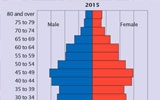How Do U.S. Populations Stack Up? Reading, Analyzing, and Creating Population Pyramids
How Do U.S. Populations Stack Up? Reading, Analyzing, and Creating Population Pyramids
Activity Description

Students will use U.S. Census Bureau data to learn how population pyramids describe population structures and to calculate age range population percentages for a selected state that will help them create a population pyramid.
Suggested Grade Level
12
Approximate Time Required
90 Minutes
Learning Objectives
- Students will be able to compare the population structures of various U.S. cities based on economic and socioeconomic information.
- Students will be able to calculate the age range population percentages for a selected U.S. state.
- Students will be able to create a population pyramid based on age and gender percentages.
- Students will be able to predict possible outcomes of changing age-dependency ratios and how these changes might impact government policy.
Materials Required
- The student version of this activity, 25 pages; it contains images that should be printed in color.
- Colored pencils
- Graph paper
Activity items
The following items are part of this activity.
- U.S. Population Pyramid, 1980
- U.S. Population Pyramid, 2015
- U.S. Projected Population Pyramid, 2040
- Population Pyramid of Punta Gorda, Florida, and Provo-Orem, Utah, 2010
- Population Pyramid of the New Orleans-Metairie-Kenner, Louisiana, Metro Area, 2000 and 2010
- Data Sheets for Age and Gender Population Structures by State
Teacher Notes
Bloom's Taxonomy
Creating


Students will compute age and gender structure percentages and create a population pyramid for a U.S. state
based on recent Census Bureau counts.
Subject
High School Geography
Topics
- Age dependency
- Demographics
- Population
Skills Taught
- Calculating percentage of total population by age and gender
- Comparing and contrasting
- Creating population pyramids
- Reading and analyzing population pyramids
Page Last Revised - September 2, 2025




